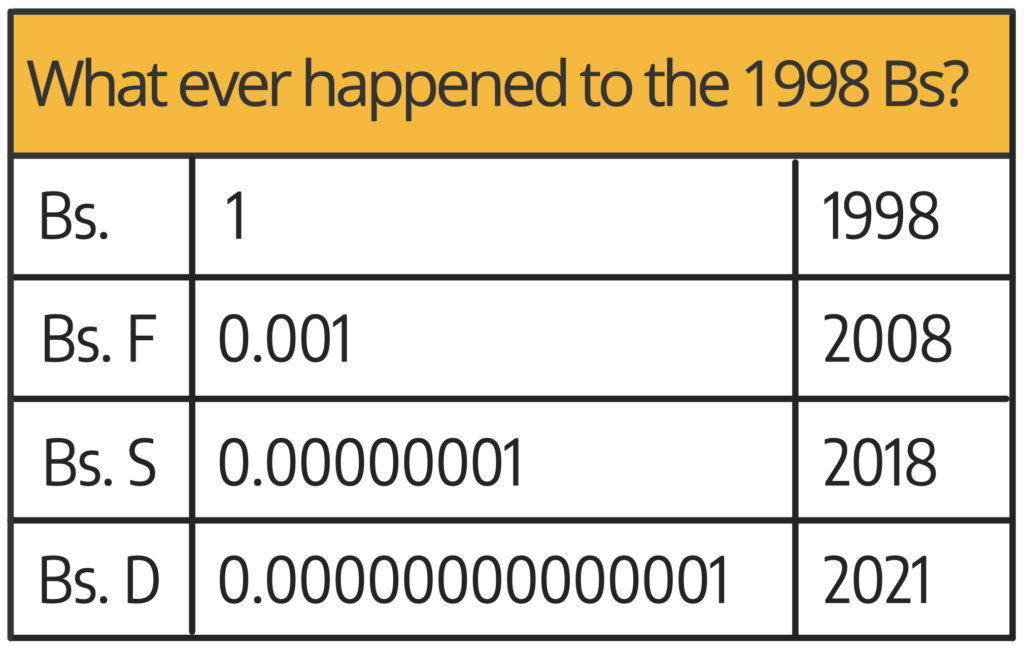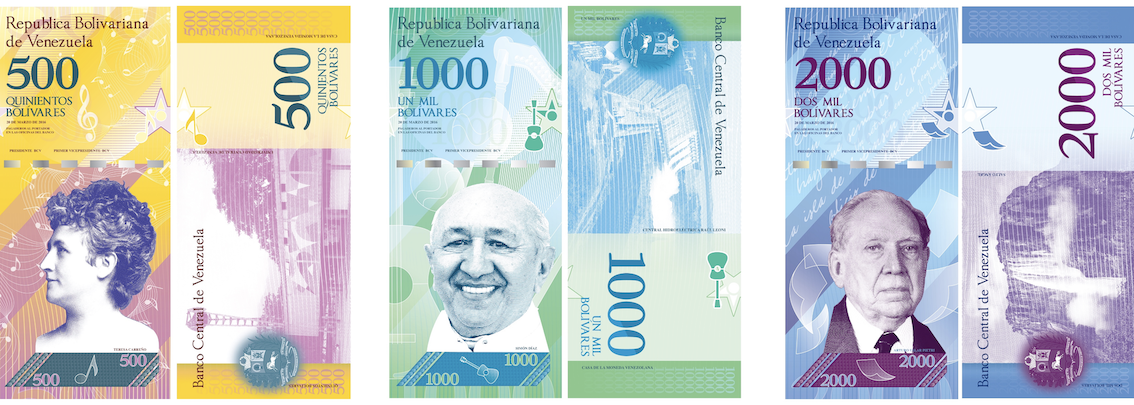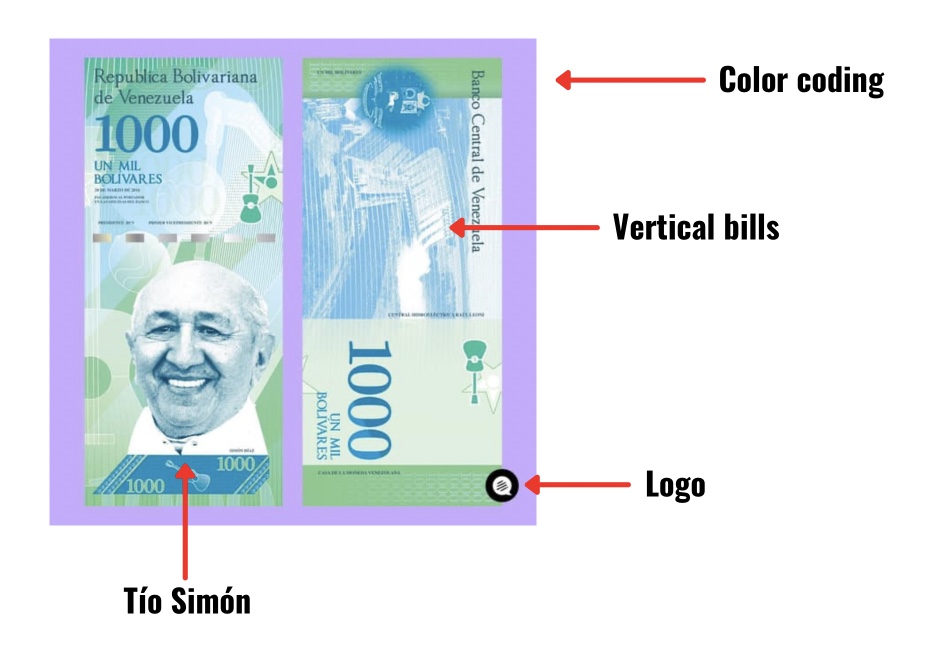UPDATE: check out the collection on opensea.
TL;DR: On the occasion of Venezuela’s third currency redenomination of the century, Caracas Chronicles is making an NFT drop of its own bills—originally designed and released for a 2015 campaign to shed light on the country’s insane monetary policy. The campaign went viral and confused many Venezuelan bigwigs back then. It was hilarious. This is the beginning of a project to integrate blockchain solutions to design a sustainable model to fund independent journalism in Venezuela (starting with Caracas Chronicles, and our sister site, Cinco8).
We’ve made available a discord channel for anyone interested to join in and have access to the team and to the early bird collection.
First, a Sad Story

4 Variants of BS
Venezuela’s bolivar is heading to its 3rd currency redenomination of the 21st century. We went from the plain old bolivar (Bs.), whose demise started in the ’80s after the Venezuelan Black Friday, to Hugo Chávez’s bolivar fuerte (Bs.F)—which slashed three zeros from the old Bs. Then, just as hyperinflation was kicking in, the administration of Nicolás Maduro took five zeros (odd number) from the Bs.F to give us the bolivar soberano (Bs.F) in 2018. Just four years later, as Venezuela’s national currency has almost become obsolete, Maduro comes with a new redenomination in October 2021, slashing 6 zeros from the Bs.S to give us the bolivar digital (Bs.D).
In summary:
Let’s put these numbers into context, try to keep up:
Bs.D 1 (2021) is Bs. 100,000,000,000,000 (1998). In 1998, Bs. 100,000,000,000,000 were equivalent to US$ 178 billion (the market cap of Microsoft in 1998 was US$ 260 billion). Talk about loss of purchasing power.
Let’s go even further. If you took all the cash that was circulating in Venezuela in 1998 and stored it in a warehouse, today it would be worth 3 cents. What can you buy with 3 cents? Well, in Venezuela, nothing… except 24 liters of subsidized gasoline.
CC’s Digital Currency Meme
During the days of pre hyperinflation Venezuela circa 2016, we saw how the Bs.F was rapidly losing purchasing power. Venezuelans needed wads of cash to make small day-to-day transactions. Looking ahead to the likelihood of the introduction of new banknotes with larger denominations into the system, we decided to hold a contest to choose civilian figures for our own Caracas Chronicles bills proposal, sure that we could do a better job than the Central Bank. The winners included some very popular figures like cultural promoter Teresa Carreño and beloved folk singer Simón Díaz, and a quite controversial one, politician and writer Arturo Uslar Pietri. So we commissioned designer and artist Erasmo Ferrante with the task of designing our bills. The result was so realistic that the bills went viral and you could see politicians from both sides criticizing and praising the new banknotes. Albeit unintended, it was scandalous and beautiful.
Since then, Venezuela has been suffering a profound monetary crisis and is heading to the longest hyperinflation in history. The people started relying heavily on online banking as cash became scarce and eventually an informal dollarization process started taking place in the country. Meanwhile, as some Venezuelans started adopting crypto to charge for services and send remittances, and Btc mining became widespread for the cheap electric service, the government decided to jump in by launching the infamous Petro, a centralized crypto-something which today is the mandatory currency (?) for some bureaucratic transactions. From early on we criticized Petro for the scam it was and started looking at how Venezuelans were using cryptocurrency and other digital solutions to go around the walls of the global financial system that had isolated them. We’ve also done extensive research with our consulting division on the viability of crypto adoption for nontech folk. Today, there’s still a long way to go, but we’ve seen that Venezuela has become an interesting ground for innovation in this field. Not for nothing it’s third in crypto adoption in the world.
A Solution to Our Biggest Pain
The Venezuelan media landscape is going through a profound crisis. The short version is that the government bought, expropriated, choked, and criminalized newspapers, radio stations, and TV networks to a point in which they were able to take over the complete media apparatus. In their place, hundreds of independent digital media outlets sprouted. Venezuelan journalism didn’t disappear, it transformed. But soon enough, the question came of who would pay those journalists, editors and staff, the technology, the lawyers, and all which was required for small news organizations to survive in such a hostile environment. Most of them have found funding through international media grants, others have financiers with deep pockets, but we decided to give it a shot as a business. And it has worked for us because we were able to keep our editorial line completely independent from whatever the international community decides that’s sponge-worthy in a given moment. Our model allowed us to grow. But it’s not enough. The old media model doesn’t work in Venezuela, and it’s not really working for anyone else in Latin America.
We thought that the occasion of Venezuela’s third redenomination of the century (or as we like to call it inhouse: the fourth variant), was perfect for us to drop our own bills as NFTs. We’re hoping that this will help us fund operations for a while. Independent journalism is having a hard time at the moment, and we need involved funders that understand the value of free speech and the need to develop innovative forms of funding small media organizations. In our process to evolve, we are changing the way we do things to have a less bureaucratic organization and to work even closer with journalists developing high-quality, impactful content. We also want to reduce the gap between our editorial vision and the people on the ground, as well as ensuring the best possible payday in a market that has little to offer. Our plan is for this NFT project to become a foot in the door that will allow us to develop a sustainable business model that will put this technology (and philosophy) deep in the heart of our organization.
The Tokens
We will be dropping 99 tokens total, 33 of each bill. However, we worked with our own Sofía Jaimes (the name behind Avila Composición) to make each token unique. She helped us develop a pattern of 33 colors. So we’ll have 33 color series of three tokens (Bs. 500, Bs. 1,000, and Bs. 2,000). This is a grid view of the whole collection:
Each token includes both sides of the relevant bill displayed vertically, with a color background, and the CC logo. The description of the tokens will include a short bio of the featured character and information on the locations that appear on the back of the bills.
Minting
- NFTs will be sold in a first-come-first-served drop, on October 28th
- Each NFT will be 0.05 ETH
- Purchase of a CChron NFT includes a 1-year subscription to the Caracas Chronicles Political Risk Report
If you’re interested, make sure to join our discord channelor shoot us an email at [email protected]. and the Twitter Space drop party on October 28th at 2: p.m. Hope to see you there.





